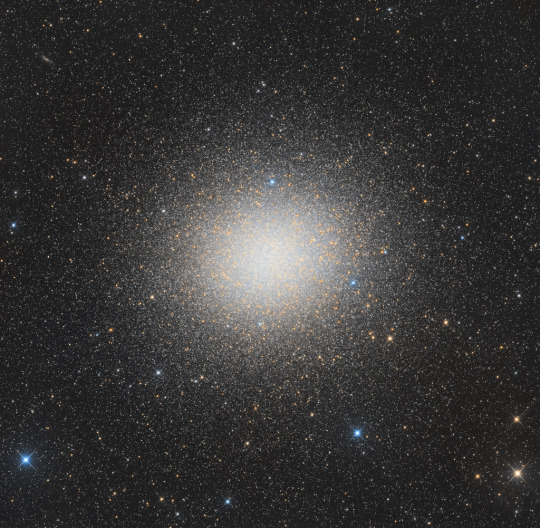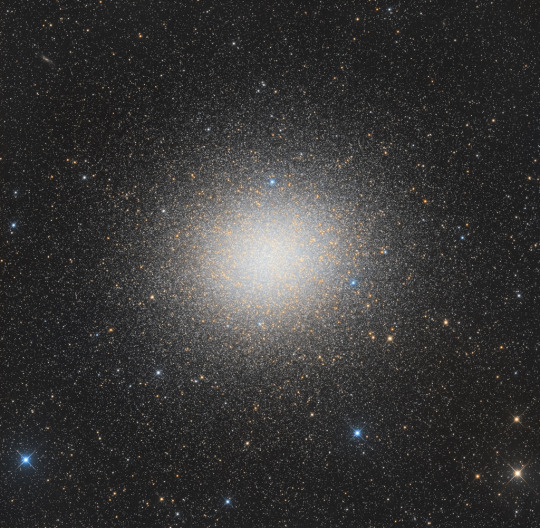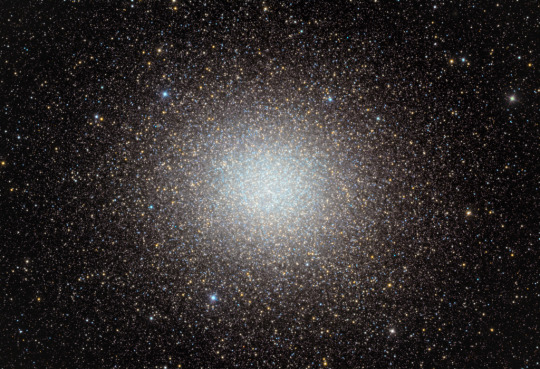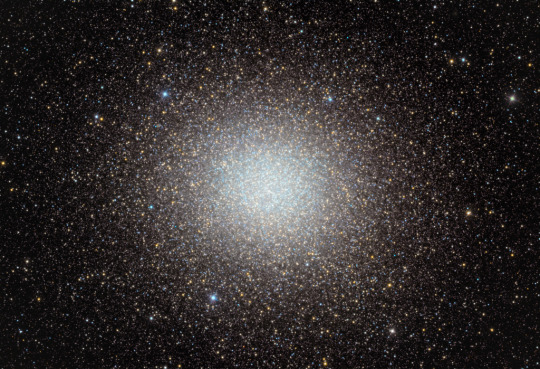#Millions of Stars in Omega Centauri
Text

1 note
·
View note
Text

Millions of Stars in Omega Centauri ©
#stars#nasa#apod#globular cluster#star cluster#astrophotography#night sky#solar system#universe#cosmos#astronomy#planet#omega centauri
404 notes
·
View notes
Photo

2024 March 28
Millions of Stars in Omega Centauri
Image Credit & Copyright: Massimo Di Fusco and Mirco Turra
Explanation: Globular star cluster Omega Centauri, also known as NGC 5139, is 15,000 light-years away. The cluster is packed with about 10 million stars much older than the Sun within a volume about 150 light-years in diameter. It's the largest and brightest of 200 or so known globular clusters that roam the halo of our Milky Way galaxy. Though most star clusters consist of stars with the same age and composition, the enigmatic Omega Cen exhibits the presence of different stellar populations with a spread of ages and chemical abundances. In fact, Omega Cen may be the remnant core of a small galaxy merging with the Milky Way. With a yellowish hue, Omega Centauri's red giant stars are easy to pick out in this sharp, color telescopic view.
∞ Source: apod.nasa.gov/apod/ap240328.html
125 notes
·
View notes
Text

Millions of Stars in Omega Centauri - February 21st, 1996.
"Pictured above is the largest ball of stars in our galaxy. About 10 million stars orbit the center of this globular cluster - named Omega Centauri - as this giant globular cluster orbits the center of our galaxy. Evidence indicates that Omega Centauri is by far the most massive of the approximate 160 globular clusters in the Milky Way. The stars in globular clusters are generally older, redder and less massive than our Sun. Studying globular clusters tells us about the history of our galaxy and the age of the Universe."
#nasa#space#cosmos#universe#astronomy#astrophysics#astrophotography#omega centauri#stars#globular cluster
134 notes
·
View notes
Text
2024 March 28

Millions of Stars in Omega Centauri
Image Credit & Copyright: Massimo Di Fusco and Mirco Turra
Explanation: Globular star cluster Omega Centauri, also known as NGC 5139, is 15,000 light-years away. The cluster is packed with about 10 million stars much older than the Sun within a volume about 150 light-years in diameter. It's the largest and brightest of 200 or so known globular clusters that roam the halo of our Milky Way galaxy. Though most star clusters consist of stars with the same age and composition, the enigmatic Omega Cen exhibits the presence of different stellar populations with a spread of ages and chemical abundances. In fact, Omega Cen may be the remnant core of a small galaxy merging with the Milky Way. With a yellowish hue, Omega Centauri's red giant stars are easy to pick out in this sharp, color telescopic view.
#astronaut#astronomers#not astrology#star#stars#art#astronomy#outer space#space#artist#galaxy#NGC 5139#NGC#Omega Centauri#cluster#star cluster#globular cluster#sun#milky way#milky way galaxy#telescope#omega cen
23 notes
·
View notes
Photo

Millions of Stars in Omega Centauri
via NASA https://ift.tt/j8BevyN
64 notes
·
View notes
Text
Omega Centauri - the greates global cluster
Omega Centauri is a globular cluster in the constellation of Centaurus that was first identified in 1677. Located at a distance of 17,090 light-years, it is the largest-known globular cluster in the Milky Way at a diameter of roughly 150 light-years.

It is estimated to contain approximately 10 million stars, and a total mass equivalent to 4 million solar masses, making it the most massive-known globular cluster in the Milky Way.
Omega Centauri is very different from most other galactic globular clusters to the extent that it is thought to have an origin as the core remnant of a disrupted dwarf galaxy.
A 2008 study presented evidence for an intermediate-mass black hole at the center of Omega Centauri, based on observations made by the Hubble Space Telescope and Gemini Observatory on Cerro Pachón in Chile. Hubble's Advanced Camera for Surveys showed that stars are bunching up near the center of Omega Centauri, as evidenced by the gradual increase in starlight near the center. Using instruments at the Gemini Observatory to measure the speed of stars swirling in the cluster's core, E. Noyola and colleagues found that stars closer to the core are moving faster than stars farther away. ‼️This measurement was interpreted to mean that unseen matter at the core is interacting gravitationally with nearby stars. By comparing these results with standard models, the astronomers concluded that the most likely cause was the gravitational pull of a dense, massive object such as a black hole. They calculated the object's mass at 40,000 solar masses.
However, more recent work has challenged these conclusions, in particular disputing the proposed location of the cluster center. Calculations using a revised location for the center found that the velocity of core stars does not vary with distance, as would be expected if an intermediate-mass black hole were present. ‼️The same studies also found that starlight does not increase toward the center but instead remains relatively constant. The authors noted that their results do not entirely rule out the black hole proposed by Noyola and colleagues, but they do not confirm it, and they limit its maximum mass to 12,000 solar masses.

The central region of Omega Centauri. The lower illustration charts the future positions of the stars highlighted by the white box in the top image. Each streak represents the star's predicted motion over the next 600 years. The period between dots corresponds to 30 years. October 2010
#astronomy#hubble#nightsky#solar system#science#nasa#constellations#astrophysics#history#greek mythology#black holes
286 notes
·
View notes
Text

Omega Centauri is our Milky Way's largest star cluster
The Beehive - where Mars is now - is what's called an open star cluster. It contains maybe 1,000 stars. But Omega Centauri, the largest globular star cluster of the Milky Way, contains about 10 million stars. This behemoth, with a diameter of about 160 light-years, is 10 times more massive than a typical globular cluster. It’s easily seen from the Southern Hemisphere and even visible from the southern half of the United States in the late evenings of May and June. Read more about this huge and unusual globular cluster.
#Omega Centauri#milky way#beehive#mars#stars#astronomy#universe#space#sky#nature#science#godscreation#god's creation
3 notes
·
View notes
Photo

The search for intermediate-sized black holes close to home Astronomers using NASA's Hubble Space Telescope have come up with what they say is some of their best evidence yet for the presence of a rare class of "intermediate-sized" black hole that may be lurking in the heart of the closest globular star cluster to Earth, located 6,000 light-years away. Like intense gravitational potholes in the fabric of space, virtually all black holes seem to come in two sizes: small and humongous. It's estimated that our galaxy is littered with 100 million small black holes (several times the mass of our Sun) created from exploded stars. The universe at large is flooded with supermassive black holes, weighing millions or billions of times our Sun’s mass and found in the centers of galaxies. A long-sought missing link is an intermediate-mass black hole, weighing in somewhere between 100 and 100,000 solar masses. How would they form, where would they hang out, and why do they seem to be so rare? Astronomers have identified other possible intermediate-mass black holes through a variety of observational techniques. Two of the best candidates — 3XMM J215022.4−055108, which Hubble helped discover in 2020, and HLX-1, identified in 2009 — reside in dense star clusters in the outskirts of other galaxies. Each of these possible black holes has the mass of tens of thousands of suns, and may have once been at the centers of dwarf galaxies. NASA’s Chandra X-ray observatory has also helped make many possible intermediate black hole discoveries, including a large sample in 2018. Looking much closer to home, there have been a number of suspected intermediate-mass black holes detected in dense globular star clusters orbiting our Milky Way galaxy. For example, in 2008, Hubble astronomers announced the suspected presence of an intermediate-mass black hole in the globular cluster Omega Centauri. For a number of reasons, including the need for more data, these and other intermediate-mass black hole findings still remain inconclusive and do not rule out alternative theories. Hubble's unique capabilities have now been used to zero in on the core of the globular star cluster Messier 4 (M4) to go black-hole hunting with higher precision than in previous searches. "You can't do this kind of science without Hubble," said Eduardo Vitral of the Space Telescope Science Institute in Baltimore, Maryland, lead author on a paper to be published in the Monthly Notices of the Royal Astronomical Society. Vitral’s team has detected a possible intermediate-mass black hole of roughly 800 solar masses. The suspected object can't be seen, but its mass is calculated by studying the motion of stars caught in its gravitational field, like bees swarming around a hive. Measuring their motion takes time, and a lot of precision. This is where Hubble accomplishes what no other present-day telescope can do. Astronomers looked at 12 years' worth of M4 observations from Hubble and resolved pinpoint stars. His team estimates that the black hole in M4 could be as much as 800 times our Sun's mass. Hubble's data tend to rule out alternative theories for this object, such as a compact central cluster of unresolved stellar remnants like neutron stars, or smaller black holes swirling around each other. "We have good confidence that we have a very tiny region with a lot of concentrated mass. It's about three times smaller than the densest dark mass that we had found before in other globular clusters," said Vitral. "The region is more compact than what we can reproduce with numerical simulations when we take into account a collection of black holes, neutron stars, and white dwarfs segregated at the cluster's center. They are not able to form such a compact concentration of mass." A grouping of close-knit objects would be dynamically unstable. If the object isn't a single intermediate-mass black hole, it would require an estimated 40 smaller black holes crammed into a space only one-tenth of a light-year across to produce the observed stellar motions. The consequences are that they would merge and/or be ejected in a game of interstellar pinball. "We measure the motions of stars and their positions, and we apply physical models that try to reproduce these motions. We end up with a measurement of a dark mass extension in the cluster's center," said Vitral. "The closer to the central mass, more randomly the stars are moving. And, the greater the central mass, the faster these stellar velocities." Because intermediate-mass black holes in globular clusters have been so elusive, Vitral cautions, "While we cannot completely affirm that it is a central point of gravity, we can show that it is very small. It's too tiny for us to be able to explain other than it being a single black hole. Alternatively, there might be a stellar mechanism we simply don't know about, at least within current physics." The Hubble Space Telescope is a project of international cooperation between NASA and ESA. NASA's Goddard Space Flight Center in Greenbelt, Maryland, manages the telescope. The Space Telescope Science Institute (STScI) in Baltimore, Maryland, conducts Hubble and Webb science operations. STScI is operated for NASA by the Association of Universities for Research in Astronomy, in Washington, D.C.
5 notes
·
View notes
Photo

Millions of Stars in Omega Centauri via NASA https://ift.tt/YaQuVRd
2 notes
·
View notes
Photo

Millions of Stars in Omega Centauri #NASA https://ift.tt/L7KDQcd
0 notes
Photo

Millions of Stars in Omega Centauri via NASA https://ift.tt/MfhSkre
2 notes
·
View notes
Photo

2023 March 16
Millions of Stars in Omega Centauri
Image Credit & Copyright: Neil Corke, Heaven's Mirror Observatory
Explanation: Globular star cluster Omega Centauri, also known as NGC 5139, is 15,000 light-years away. The cluster is packed with about 10 million stars much older than the Sun within a volume about 150 light-years in diameter. It's the largest and brightest of 200 or so known globular clusters that roam the halo of our Milky Way galaxy. Though most star clusters consist of stars with the same age and composition, the enigmatic Omega Cen exhibits the presence of different stellar populations with a spread of ages and chemical abundances. In fact, Omega Cen may be the remnant core of a small galaxy merging with the Milky Way. Omega Centauri's red giant stars (with a yellowish hue) are easy to pick out in this sharp, color telescopic view.
∞ Source: apod.nasa.gov/apod/ap230316.html
155 notes
·
View notes
Photo

Millions of Stars in Omega Centauri
Credits: Ignacio Diaz Bobillo
2 notes
·
View notes
Text
Omega Centauri
Imagine it. Ten million stars packed into a spherical shape with an overall diameter of 170 light years and an average distance between them of just a tenth of a light year.
#astronomy #universe #cosmos
NGC 5139
A Gigantic Globular Cluster
in Centaurus
Image exposure: 45 minutesImage Size:2.11º x 1.4ºImage date:2024-04-06
Imagine it. Ten million stars packed into a spherical shape with an overall diameter of 170 light years and an average distance between them of just a tenth of a light year. (The nearest stars to Earth are 4 light years away).
Also known as Caldwell 80, Omega Centauri is…

View On WordPress
#amateur astronomy#astronomía#astronomie#Astronomy#C80#Caldwell 80#Centaurus#Cluster#Cosmic Focus Observatory#cosmos#deep sky#Emission Nebula#Featured#Globular Cluster#image#nature#NGC 5139#Omega Centauri#photography#science#Skywatcher EQ6-R#Skywatcher esprit 120#space#Tenmongaku#Tiānwénxué#Universe#ZWO ASI071
1 note
·
View note
